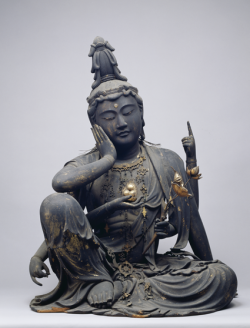Difference between revisions of "Esoteric Buddhist Sculpture / Japanese Sculpture"
(Created page with " In the beginning of the Heian period (794–1185), the priest Kūkai (774–835) brought from China into Japan a new type of Esoteric Buddhism known...") |
|||
| (One intermediate revision by the same user not shown) | |||
| Line 1: | Line 1: | ||
| + | [[File:Seated Nyoirin Kannon.png|thumb|250px|]] | ||
| + | In the beginning of the [[Heian period]] (794–1185), the [[priest]] [[Kūkai]] (774–835) brought from [[China]] into [[Japan]] a new type of [[Esoteric Buddhism]] known in [[Japanese]] as [[mikkyō]]. | ||
| − | + | [[Esoteric Buddhist]] practices worshiped a wide range of [[deities]] using [[rituals]] that required special implements, [[mystical]] incantations, and secret [[hand gestures]]. | |
| − | After [[Kūkai]], new trends in [[Esoteric Buddhism]] continued to {{Wiki|stream}} into [[Japan]] from [[Wikipedia:Tang dynasty|Tang China]] not only through the [[Shingon sect]] founded by [[Kūkai]] but also by way of [[monks]] of the [[Esoteric]] [[Tendai sect]] such as [[Ennin]] (794–864) and [[Enchin]] (814–891). These {{Wiki|priests}} [[preached]] the possibility of accumulating [[merit]] in this [[life]] through [[esoteric rituals]], and thereby gained the [[faith]] and support of [[Japan's]] {{Wiki|aristocratic}} {{Wiki|elite}}. | + | Many [[Esoteric Buddhist deities]] show the strong influence of [[Indian]] [[Hindu]] imagery—distinguished by multiple arms and faces, often with [[wrathful]] {{Wiki|expressions}}. Painted or sculptural {{Wiki|representations}} of full compendiums of these [[deities]] are called [[mandalas]]. |
| + | |||
| + | After [[Kūkai]], new trends in [[Esoteric Buddhism]] continued to {{Wiki|stream}} into [[Japan]] from [[Wikipedia:Tang dynasty|Tang China]] not only through the [[Shingon sect]] founded by [[Kūkai]] but also by way of [[monks]] of the [[Esoteric]] [[Tendai sect]] such as [[Ennin]] (794–864) and [[Enchin]] (814–891). | ||
| + | |||
| + | These {{Wiki|priests}} [[preached]] the possibility of accumulating [[merit]] in this [[life]] through [[esoteric rituals]], and thereby gained the [[faith]] and support of [[Japan's]] {{Wiki|aristocratic}} {{Wiki|elite}}. | ||
Before the {{Wiki|Edo period}}, almost all [[Japanese]] {{Wiki|sculpture}} was [[religious]] in [[nature]]. [[Buddhist]] sculptures were produced in [[Japan]] from the time [[Buddhism]] took hold in the seventh century, but the icons they represented came from [[India]] by way of [[China]], bringing with them the influence of those countries. | Before the {{Wiki|Edo period}}, almost all [[Japanese]] {{Wiki|sculpture}} was [[religious]] in [[nature]]. [[Buddhist]] sculptures were produced in [[Japan]] from the time [[Buddhism]] took hold in the seventh century, but the icons they represented came from [[India]] by way of [[China]], bringing with them the influence of those countries. | ||
| − | One of the {{Wiki|distinctive}} [[characteristics]] of [[Japanese]] {{Wiki|sculpture}} is its use of [[wood]] as a primary material. Because sculptures were made of [[wood]], various construction styles and techniques were developed, including joint-block construction (yosegi zukuri) and inlaid {{Wiki|crystal}} [[eyes]]. | + | One of the {{Wiki|distinctive}} [[characteristics]] of [[Japanese]] {{Wiki|sculpture}} is its use of [[wood]] as a primary material. |
| + | |||
| + | Because sculptures were made of [[wood]], various construction styles and techniques were developed, including joint-block construction (yosegi zukuri) and inlaid {{Wiki|crystal}} [[eyes]]. | ||
[[Japanese Buddhist]] sculptures from various historical periods exemplify the repeated waves of influence from the {{Wiki|Asian}} mainland and subsequent [[Japanese]] innovations, leading to a rich variety of sculptural styles. | [[Japanese Buddhist]] sculptures from various historical periods exemplify the repeated waves of influence from the {{Wiki|Asian}} mainland and subsequent [[Japanese]] innovations, leading to a rich variety of sculptural styles. | ||
| + | {{R}} | ||
| + | http://www.kyohaku.go.jp/eng/theme/floor1_2/past/scu_20150102.html | ||
| + | [[Category:Deities]] | ||
| + | [[Category:Esoteric Buddhism]] | ||
| + | [[Category:Japanese Buddhism]] | ||
Latest revision as of 07:52, 3 November 2015
In the beginning of the Heian period (794–1185), the priest Kūkai (774–835) brought from China into Japan a new type of Esoteric Buddhism known in Japanese as mikkyō.
Esoteric Buddhist practices worshiped a wide range of deities using rituals that required special implements, mystical incantations, and secret hand gestures.
Many Esoteric Buddhist deities show the strong influence of Indian Hindu imagery—distinguished by multiple arms and faces, often with wrathful expressions. Painted or sculptural representations of full compendiums of these deities are called mandalas.
After Kūkai, new trends in Esoteric Buddhism continued to stream into Japan from Tang China not only through the Shingon sect founded by Kūkai but also by way of monks of the Esoteric Tendai sect such as Ennin (794–864) and Enchin (814–891).
These priests preached the possibility of accumulating merit in this life through esoteric rituals, and thereby gained the faith and support of Japan's aristocratic elite.
Before the Edo period, almost all Japanese sculpture was religious in nature. Buddhist sculptures were produced in Japan from the time Buddhism took hold in the seventh century, but the icons they represented came from India by way of China, bringing with them the influence of those countries.
One of the distinctive characteristics of Japanese sculpture is its use of wood as a primary material.
Because sculptures were made of wood, various construction styles and techniques were developed, including joint-block construction (yosegi zukuri) and inlaid crystal eyes.
Japanese Buddhist sculptures from various historical periods exemplify the repeated waves of influence from the Asian mainland and subsequent Japanese innovations, leading to a rich variety of sculptural styles.
Source
http://www.kyohaku.go.jp/eng/theme/floor1_2/past/scu_20150102.html
